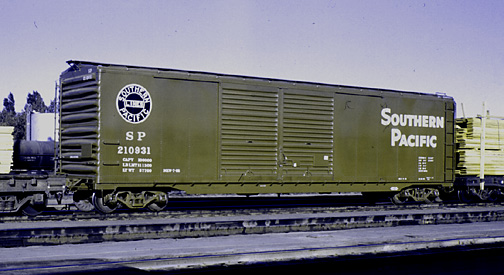
The thought of taking a nice new freight car that I had just assembled from a kit and weathering it to look like it has been over the railroad a million miles just has been one of those project that I have been avoiding for years.

My fellow model railroaders have given me a little heat about my un-weathered freight car fleet. My comment has been, "Its not raining in the train room." I could also show them a picture of clean freight cars like this one.
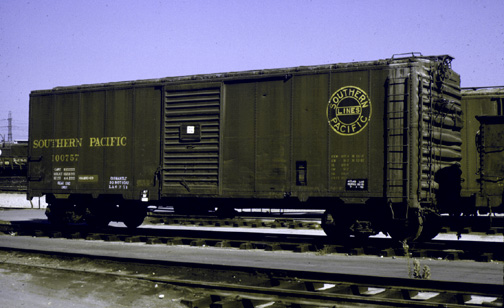
Freight cars do get dirty and rusty after years of service, so rather than just slop paint on my HO cars, I thought that a little photo study on the subject should be done first.
Along with looking over the many photos that I had taken over the years, I found another valuable resource by reviewing old train videos that I hadn't seen for a while. (May I suggest doing this video study in the easy chair with a favorite drink and snack food.)
I model the Southern Pacific Railroad during the mid 1960s and was looking for specific information about the general condition of SP freight cars along with other railroad companies equipment. I discovered that freight cars were in better condition weathering wise than cars that run the rails today. For example:
1. A box car built in 1950 would only be 15 years old on my 1965 layout. But a freight car on today's railroad that may have been built in 1965 would make it 35 years old, and this is not uncommon to see at least one in a freight train.
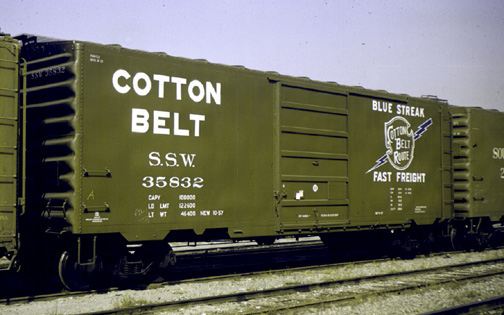
2. Cars owned by class one railroads during the 50s and before were usually repainted after so many air dates, and then usually with later lettering style reflecting the currant advertising slogan. Note in the above picture is the slogan FAST FREIGHT. A box car may have been repainted within a ten year period. This process of repainting of freight cars stopped in the late 1950s on the SP because of cost cutting reasons.
3. Lead based paint worked well on older cars making them look good for many years. But lead based paints are illegal now days and modern paints do not hold up as well to the elements.
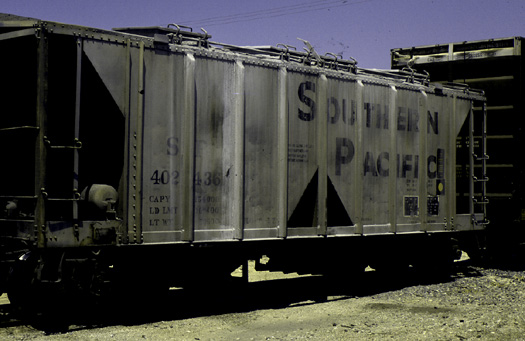
6. Cars used for a particular service like a covered hopper used to carry concrete would usually never get repainted. A hopper covered with concrete dust would only make lettering appear faded.
Most my fleet of freight cars were built in the 1950s, repainted box car dates would look fresh gloss look or lighter weathering such as dust.

The original paint on older cars would in turn show more weathering.

I wanted a toned down and faded look for my box car red fleet, so to look like they were in service for a while but still in good condition. I used brown Latex house paint diluted into water as a wash with a few drops of Isopropyl Rubbing Alcohol added to make the wash color flow on the cars painted surface and without beading up. I use a large soft art brush that will hold plenty of wash when coating the a box car the first time.
The snap-on plastic box car body is separated from its underframe because I found it easier to hold onto the inside shell of the car keeping my fingers away from the outside surface.
The wash color will collect in corners and along rivet rows of the car, this first coat will start the process of weathering. I like to do this outdoors on a sunny day so the car will dry quickly and another wash applied. Because it takes a few minutes for the car to dry, I can weather 3 or 4 cars of the same type at a time. I also use a hand-held hair drier on LOW and hand hold the car turning it constantly. Be careful not to warm the plastic too much for obvious reasons.
Now that the first car has dried, you may notice that not much has happened, maybe the white lettering is a little duller. This is good...This type of weathering takes a few wash coats until the desired hue of dust is reached.
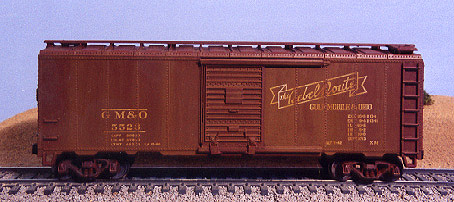
Apply the second wash coat and let it dry a little, then concentrate the brush strokes on rivet rows and other corners. Work on one side at a time and let that side dry facing up, otherwise the wash coat will tend to run. Because wash coats are a slower process than a one time shot, it will be easier to control the desired weathering effect.
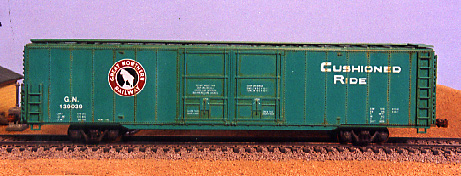
During the 1960s the railroads were building larger and more colorful cars. I really like the looks of this Con-Cor, Great Northern, 60 foot box, but I thought it was always a bit bright on the layout and maybe that's why I had left it in storage drawer.
I use the same method as above for weathering cars painted box car red, but after the car is finished I then use a cloth wet with alcohol to wipe the car sides down. This will remove the brown weathering on the panels but leaves brown in the rivet rows. The alcohol also causes a desirable bleaching effect on the paint and lettering too. Be careful and do not get carried away with rubbing the car side, it only take a few wipes downward to see the effect. After the alcohol has evaporated, wipe the car side with a soft dry cloth. This will give slight sheen to the car side.
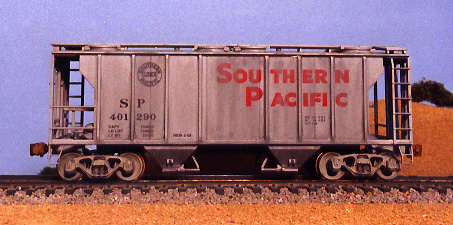
For these type of cars I used a color that matches powdered concrete gray. Mixing a Latex wash about twice as much paint in with water and alcohol as I did mixing the box car wash coat, this is because the prototype cars are covered heavily with concrete dust. My fleet is made up of those nice Atlas Covered Hopper cars because they are well detailed and ready to run. A little more care in handling them should be used so as not to be enshrined them with a personal finger print.
Concrete dust gets over everything including the trucks when these cars are being loaded at the plant.
Now apply the gray wash over the car allowing the first coat to dry, then do the second wash coat. While the second coat is still damp I use a very small amount of gray paint right out of the can on the tip of the brush, painting sides of the car downward from the roof hatch covers.
I hope this web article is a help for my fellow model railroaders, if you have a question about this weathering process please email me.
